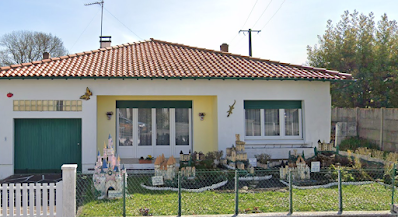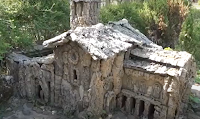 |
all images (2014) by Marcel Albet, from his weblog,
licensed under Creative Commons 3.0 |
The house pictured above, with its exterior walls full of decorations, is located in Llinars del Vallès, a municipality with some 9800 inhabitants (2018) in the province of Barcelona, Spain, about forty kilometers north-east of the city of Barcelona.
The house was designed by Joan Diaz, who moved in with his wife and two children, and in 1990 began a decorating project that he would continue for many years.
Life and works
Joan Diaz was born in 1941 in the French town of Montauban, at a time when his parents lived there as migrants, having fled from Spain because of the civil war.
When the war officially ended in 1939, the family soon after his birth returned to Spain and so young Joan would grow up there.
From an early age Joan was attracted to art, he enjoyed painting and drawing, played the violin and the piano, sang in his school choir and played the organ in the local church at weddings.
However, he chose to study technical architecture and architectural drawing, but did not complete it, because he was able to get a job with the municipality of Granollers, which he would hold for 17 years, while at the same time he was working with his father in the family business of building grain silos.
In 1965, at the age of 24, he bought a plot of land in the municipality of Llinars del Vallès, which, like Granollers, was located northwest of Barcelona.
Joan Diaz had acquired sufficient knowledge during his studies in architecture to make the drawings of the design of his future house himself.
The top image in this post shows partly what he had in mind for the building to arise on the corner of three streets.
The front of the house with the main entrance is along the Carrer Carvantes.
The right side of the house has a slightly receding side aisle, that faces the Carrar Jacint Verdagner and is separated from the street corner by a high wall, provided with a second entrance.
The left side of the house, not visible on the image on top of this post, is decorated with a low transparent fence that runs from the main entrance to the second side street, the Passage Cervantes.
Behind this fence is an open area, separated from the Passage Cervantes by a stone wall as high as the iron fence, which continues up to the side wall of a neighboring house.
In 1969 the house was ready and Joan Díaz and Asunción Pantanigrós, whom he had married in the meantime, could move in there.
Although he undoubtedly thought about decorating the house, he was too busy in the first decades of his marriage to actually start doing so. The couple had two daughters and their upbringing required a lot of attention, as did the work he did for his father in addition to his own job at the municipality of Granollers
It was not until the end of the 1980s, when he was approaching the age of fifty, that he started taking steps in the direction of creating decorations by undertaking a pilot project.
This worked out so well that he actually started decorating his house in the early 1990s, a project he continued at least until 2019, when he was approaching the age of eighty.
Joan Diaz created a series of increasingly complex and often large mosaic paintings on both the inside and outside of his house, an imaginative work with many trencadis and wrought iron elements, full of references to the landscapes of the region and to rural and traditional Catalan life.
His wife supported him in his creative activities and, not without reason, the neighbours and the municipality were also positive about it.
The website Artworks from Casa Pratginestós (see Documentation) provides an illustrated overview of what he created in the period 1990=2019.
Documentation* Weblog (undated)
Obras de Arte de Casa Pratginestós (Artworks from Casa Pratginestós) with 190 photos of the site selected by subject and yearof creation.
*
Article (2016) by Jo Farb Hernámdez on website
SPACES Archive* Article (2024) on website
Rondaller *
Entry (2024) with a series of photos on the weblog of
Marcel Albet* Entry on the website of Tripadvisor wirh some 30 photos
Joan Diaz,
Casa Pratginestós .
Carrer Cervantes, 18,
08450 Llinars del Vallès, Barcelona, Spain
decorations can be seen from the street
interior is in general not open to visitorsGoogle Streetview: right side,of the property, left side of the property























































